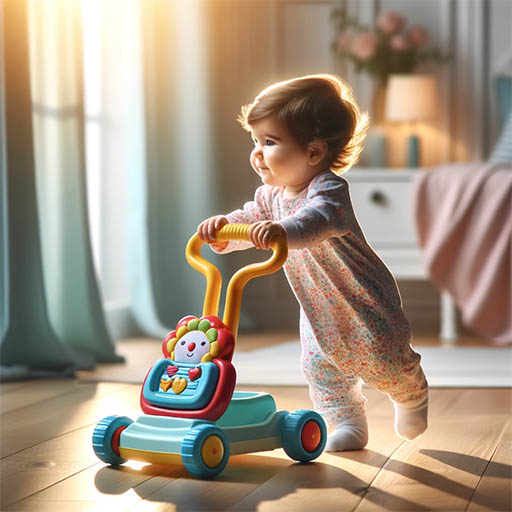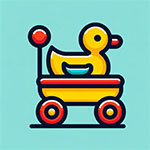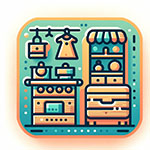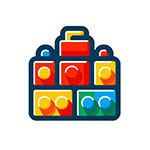As babies transition from their first year into toddlerhood, their play becomes more dynamic, exploratory, and interactive. This period is marked by significant milestones such as walking, talking, and refined motor skills. Toys for children aged 12 to 18 months should encourage these developments, offering opportunities for learning and exploration. Here are the 15 most recommended toys for child development for ages 12 to 18 months, with a focus on the developmental benefits they provide:

Below, you’ll find affiliate and referral links for products I genuinely recommend as a pediatric occupational therapist. If you decide to make a purchase through these links, I may earn a commission at no extra cost to you. This helps keep us up and running. For full transparency, please refer to my disclosure policy. As an Amazon Associate, I earn from qualifying purchases made through these links.
1. Walk-Behind ToysDevelopmental Benefits: Walk-behind toys serve as engaging companions for toddlers mastering the art of walking, providing both support and motivation. These toys often include multiple activities that enhance cognitive abilities, such as buttons that play music or lights that encourage interaction, thereby supporting both physical and mental development. The process of pushing these toys strengthens leg muscles, improves balance, and enhances coordination, offering a multifaceted approach to developmental growth. |
2. Simple Shape SortersDevelopmental Benefits: Shape sorters are classic educational toys that challenge toddlers to match each shape with its corresponding slot, promoting cognitive skills through the problem-solving required to identify and sort shapes correctly. This activity enhances fine motor skills and hand-eye coordination while also introducing toddlers to basic concepts of geometry, such as circles, squares, and triangles. The repetitive nature of the task reinforces memory and recognition, making it a fundamental tool for early learning. |
3. Board Books with Simple StoriesDevelopmental Benefits: Board books with simple stories are designed to withstand the curiosity and energy of toddlers, featuring sturdy pages that are easy for little hands to turn. The combination of captivating illustrations and engaging narratives stimulates toddlers’ imaginations, laying the groundwork for language development and early literacy skills. Reading these stories together encourages bonding and instills a love for reading from a young age, enhancing vocabulary and listening skills. |
4. Large Building BlocksDevelopmental Benefits: Large building blocks offer a hands-on learning experience that fosters creativity and spatial awareness. As toddlers stack, build, and knock down structures, they experiment with balance and learn about shapes and sizes, honing their problem-solving skills. This playtime activity encourages imaginative thinking and provides a tangible way to express ideas, while the act of manipulating the blocks improves fine motor skills and coordination. |
5. Push and Pull ToysDevelopmental Benefits: Push and pull toys are ideal for encouraging movement and exploration as toddlers become more mobile. These toys mimic real-life activities, such as vacuuming or walking a dog, providing a sense of accomplishment and independence. The physical activity involved strengthens muscles and develops gross motor skills, while the cause-and-effect relationship of pushing or pulling the toy adds a layer of cognitive development. |
6. Play Kitchens and FoodDevelopmental Benefits: Engaging in pretend play with play kitchens and food sets not only sparks imagination but also teaches toddlers about daily routines and healthy eating habits. This type of play enhances language development as children engage in role-playing, negotiating roles, and storytelling, providing a rich context for vocabulary expansion. It also introduces basic math concepts through counting and sorting play foods, making it a comprehensive developmental tool. |
7. Musical InstrumentsDevelopmental Benefits: Introducing toddlers to simple musical instruments encourages exploration of sounds and rhythms, fostering an early appreciation for music. Playing instruments such as drums, xylophones, or keyboards supports auditory development, enhances fine motor skills through manipulation of the instrument, and introduces basic concepts of cause and effect as toddlers see the immediate response to their actions. |
8. Puzzles with Large PiecesDevelopmental Benefits: Puzzles tailored for toddlers feature large, easy-to-grasp pieces that fit into a corresponding board, improving cognitive skills through the challenge of matching each piece to its place. This activity promotes hand-eye coordination and fine motor skills, as toddlers must manipulate the pieces to fit correctly. The satisfaction of completing a puzzle boosts confidence and provides a sense of achievement, encouraging persistence and problem-solving. |
9. Balls of Different SizesDevelopmental Benefits: Playing with balls of various sizes and textures engages toddlers in physical activity that enhances gross motor skills, coordination, and spatial awareness. Throwing, catching, and rolling balls teach basic physics concepts like motion and gravity, along with social skills such as taking turns and cooperation during group play. This simple yet versatile toy supports a wide range of developmental benefits, from physical fitness to understanding relationships between cause and effect. |
10. Activity TablesDevelopmental Benefits: Activity tables captivate toddlers’ attention with their assortment of sensory experiences and interactive elements, such as spinning gears, sliding beads, and buttons that produce sounds. These features stimulate fine motor development, cognitive abilities, and sensory exploration, offering a platform for independent discovery and learning through play. The variety of activities provided encourages curiosity and experimentation, making activity tables a dynamic resource for early development. |
11. Ride-On ToysDevelopmental Benefits: Ride-on toys promote physical activity and mobility, strengthening leg muscles and improving balance as toddlers learn to propel themselves forward. These toys offer a sense of independence and adventure, enhancing spatial awareness and coordination. The action of riding mimics real-life transportation, providing a context for imaginative play and exploration of the surrounding environment. |
12. Dolls and Stuffed AnimalsDevelopmental Benefits: Dolls and stuffed animals serve as companions for toddlers, fostering emotional development and empathy through caregiving play. Pretend interactions with these toys enhance social skills, as toddlers engage in dialogue and role-play, practicing expressions of care, kindness, and friendship. This imaginative play supports language development and emotional intelligence, laying the foundation for future interpersonal relationships. |
13. Interactive Learning ToysDevelopmental Benefits: Interactive learning toys respond to toddlers’ actions with lights, sounds, or music, providing immediate feedback that captivates their attention and encourages continued exploration. These toys often introduce early academic concepts, such as numbers, letters, and colors, in a playful and engaging manner, supporting language development and cognitive growth. The interactive nature of these toys reinforces learning through repetition and play, making education a fun and dynamic experience. |
14. Sand and Water TablesDevelopmental Benefits: Sand and water tables offer a sensory playground that encourages exploration, creativity, and physical dexterity. Manipulating sand and water with tools like shovels, buckets, and molds teaches basic scientific concepts such as volume and density, while the tactile experience can have a calming effect, promoting emotional regulation. This form of play encourages imaginative scenarios and cooperative play, enhancing social skills and problem-solving abilities. |
15. Art SuppliesDevelopmental Benefits: Providing toddlers with safe, easy-to-use art supplies such as crayons, markers, and paper supports creative expression and fine motor development. Drawing, coloring, and crafting enable toddlers to explore colors, shapes, and textures, fostering artistic skills and imagination. This form of self-expression is essential for emotional development, allowing children to communicate feelings and ideas in a visual format, enhancing their sense of individuality and self-esteem. |
Toys for toddlers aged 12 to 18 months should not only be fun but also support their rapid development. Each toy listed here is designed to stimulate growth in key areas such as cognitive, language, motor, and social-emotional skills, ensuring that toddlers are engaged, learning, and developing through play.








